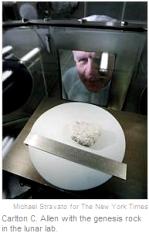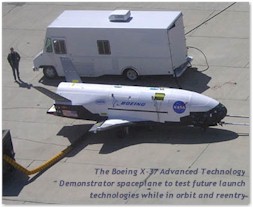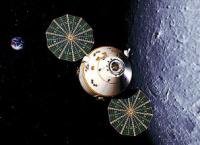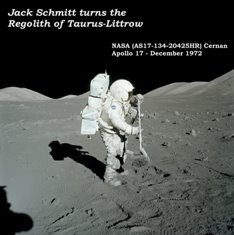 In Stained-Glass Awe, the NYT finds fit to print NASA's Lunar Lab, Marks Moon's move to Mainstream.
In Stained-Glass Awe, the NYT finds fit to print NASA's Lunar Lab, Marks Moon's move to Mainstream.(Are these the same people who ridiculed Dr. Goddard?)
Guy Gugliotta
The New York Times
HOUSTON — In the lab, the
Moon rocks look nondescript — dark gray basalt, a whitish mineral called anorthosite and mixtures of the two with crystals thrown in. Yet nearly 40 years after the Apollo astronauts brought the first rocks back to
Earth, these pieces of the Moon are still providing scientists with new secrets from another world.
“We call this one the ‘genesis’ rock, because it was formed close to the time the Moon solidified about 4.5 billion years ago,” said Carlton C. Allen, pointing to a light-colored stone about the size and shape of a large artist’s eraser, resting inside a glove box filled with inert nitrogen gas.
“We know the Big Bang happened about 14.5 billion years ago,” Mr. Allen said, “and this rock is a third that old. You will never see a solid piece of stuff in our solar system that is any older.”
Mr. Allen is the astromaterials curator at the Johnson Space Center, home of the Lunar Sample Laboratory Facility, a secure repository opened in 1979 to house 842 pounds of Moon rocks and soil collected by astronauts in six visits.
The rocks on the lunar surface, lying virtually unchanged in a weatherless vacuum since their formation, offer opportunities to investigate the origin and evolution of the solar system available nowhere else, and the study deepens with each new generation of scientists and scientific instruments.
Each year an independent peer review panel evaluates new research proposals, and curators mail out about 400 lunar samples to 40 to 50 scientists worldwide. Almost all are less than one gram in size. “We don’t hand them out, we only loan them,” Mr. Allen said. “We’re not planning to run out any time soon.”
Over the years, the samples have provided uncounted insights into the nature of our closest celestial neighbor. Because of the samples, we have learned when the Moon was formed, probably (although it is still controversial) the result of a planetoid smashing into the young Earth, throwing a cloud of debris into space that subsequently came together in a sphere.
The samples have confirmed that asteroid and meteor impacts, not volcanism, created the vast majority of craters that define the Moon’s topography, while a constant barrage of meteorites, micrometeorites and radiation melted and pureed the bedrock to create the blanket of fine-grained soil and dust — known as regolith — that now cloaks the lunar surface.
And knowing the ages of Moon rocks, which can be computed to within 20 million years, has enabled scientists to establish a baseline that allows them to date geologic features throughout the solar system. The surface of the Earth, one of the solar system’s youngest topographies, is constantly changing, as it is faulted, folded, shaped and reshaped by eruptions, earthquakes and erosion. By contrast, the Moon is as old as it gets.
“It’s hard to wrap your mind around a place where nothing ever happens,” Mr. Allen said. “But the Moon is that place.”
In recent years the rocks have also helped researchers to answer practical questions that have emerged since President Bush’s 2004 proposal to return to the Moon by 2020 and set up a permanent outpost. Planners are using the rocks to study the pernicious effects of regolith on machinery and astronaut health. They are learning how to extract oxygen and other vital elements from lunar rocks and soil. And they need to understand how to shield living spaces from the deadly radiation that eternally pounds the lunar surface.
The samples — 2,200 of them — are kept in nitrogen-filled boxes in a stainless steel vault on the second floor of the 14,000-square-foot repository, and are transferred to other parts of the lab in airlocks. Technicians prepare shipments in glove boxes containing sterile tools and containers.
The samples are numbered and sorted by expedition. All of the Apollo landings, beginning with Apollo 11’s historic mission in 1969 and ending with Apollo 17 in December 1972, were at equatorial sites, but terrain differed each time and the samples reflect the differences. The genesis rock was collected by Apollo 15 astronauts near Hadley Rille at the border between a lowland “sea,” or mare, and the lunar highlands.
The arrival of the first Moon rocks in 1969 was eagerly anticipated by scientists. “We had no idea what the Moon was made of,” Mr. Allen recalled, and the first two decades of research focused on basic questions — the age and composition of the Moon rocks and the origin and evolution of the Moon’s geology and salient topographical features.
The early Moon developed as a mostly liquid ball of magma covered with a thin crust of lighter minerals. The crust became the white anorthosite, which floated atop the magma to form the lunar highlands. The basalt erupted later and subsequently solidified in the lowland marea.
The anorthosite and similar rock types in the highlands and basalt lavas in the marea are the Moon’s basic building blocks. Other rocks are breccias — crushed and broken rock fragments, fused by the heat from impact collisions and ejected from the resulting crater.
Researchers saw that the highlands had more craters than the marea. This meant they had been hit with more impacts so the highland rocks were relatively older. But once they had the rocks in hand, they could determine their absolute age in years.
This enabled them to make a template that could work anywhere in the solar system. The Moon showed that a site with rocks of a certain age would have a predictable number of craters of different sizes. And since the rate of impacts was presumably similar throughout the solar system, the lunar dates could be used as a benchmark to estimate the age of surfaces elsewhere.
“This was a key thing, that impact was a significant and fundamental phenomenon that affected not only the Moon and planets, but life itself,” said the planetary geologist Paul D. Spudis, of the
Lunar and Planetary Institute in Houston. “We had known that impacts occurred, but until the rocks, we had viewed them as a geological oddity.”
No longer. In the early 1980s, scientists were able to show that terrestrial mineral and crystal deposits 65 million years old were similar to those found routinely in lunar ejecta. This led to the now widely accepted theory that the consequences of an asteroid impact had wiped out the dinosaurs.
Lunar scientists now suspect this insight may have further implications. Analysis of the lunar samples and impact craters has shown that the Moon’s surface was solid 4.3 billion years ago, yet the oldest impact rocks among the samples are 3.9 billion years old.
Some researchers have suggested that impacts on the moon began to taper off 4.3 billion years ago, only to resume with a vengeance in a “cataclysm” 400 million years later. And if the cataclysm affected the Moon, it also affected the Earth — at a time when life was just beginning.
“This is very controversial,” said Charles Shearer, a lunar scientist at the
University of New Mexico and the chairman of the lunar lab’s peer review committee. “It’s probably important to sample other terrains.”
This is part of the lure of Mr. Bush’s lunar initiative, which calls for a base near the South Pole and exploration of the Moon’s entire surface, including the far side. These possibilities, Mr. Allen said, “have the scientific community really jazzed.”
 NASA managers have agreed to push back the anxiously anticipated launch of the Lunar Reconaissance Orbiter (LRO) & LCROSS joint mission payload until a set of 18 favorable launch windows open at the end of February entending through March 2009.
NASA managers have agreed to push back the anxiously anticipated launch of the Lunar Reconaissance Orbiter (LRO) & LCROSS joint mission payload until a set of 18 favorable launch windows open at the end of February entending through March 2009. 




